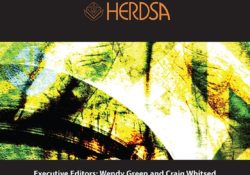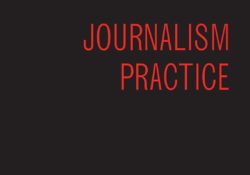
tandfonline.com har udgivet en rapport under søgningen “Teacher Education Mathematics”: ABSTRACT ABSTRACT Inclusive learning environments have been described as a crucial factor for fostering disabled students’ sense of belonging in higher education. However, few empirical studies have elaborated on how learning environments contribute to disabled students’ belonging. In this study, we have taken a socio-political approach and widen the theoretical understanding of ‘belonging’. We analyse three Finnish disabled students’ narrative interviews concerning their experiences of learning environments through a narrative approach. Our findings highlight the complex interplay of learning environments and belonging in the context of STEM and large class sizes. We discuss the role of active learning environments for supporting disabled students’ belonging. The narratives show how not belonging might be more productive for these students, as the learning… Continue Reading →
Like this:
Like Loading...
eric.ed.gov har udgivet: This book offers guidelines for elementary school teachers for making adaptations in reading and mathematics instruction for students with mild disabilities in the general education classroom. Following an introductory chapter, Chapter 1 presents eight principles for materials adaption organized according to the acronym FLEXIBLE: F-feasible (adaptations must be feasible in the classroom), L-lively (adaptations must be lively and fun), E-eliminated (adaptations must have the goal of being eventually faded out), X-explicit (adaptations must have a definite explicit purpose), I-intentional (adaptions should be part of a comprehension individualized plan), B-beneficial (adaptations should benefit the student with disabilities without detracting from the learning of other students), L-limelight (adaptations do not place undue attention on the student with disabilities), and E-evaluated (adaptations should be evaluated on an ongoing basis). Chapter… Continue Reading →
Like this:
Like Loading...
tandfonline.com har udgivet en rapport under søgningen “Teacher Education Mathematics”: ABSTRACT ABSTRACT Inclusive teaching practices can be characterized as recurrent ways how teachers work with their students’ diverse abilities, but how exactly are they enacted in subject matter classrooms? The paper proposes a conceptual framework to unpack inclusive practices according to the student ability to which they refer, in five typical jobs for teachers: (a) identifying the demands for the ability, (b) differentiating learning goals, (c) compensating for low abilities, (d) enhancing abilities, and (e) addressing the abilities in joint learning. The proposed job-ability framework for inclusive teaching practices is substantiated in a video study of 25 mathematics lessons on percentages with the same curriculum material. In total, rather than 50, 133 different inclusive teaching practices were identified in 3862… Continue Reading →
Like this:
Like Loading...
tandfonline.com har udgivet en rapport under søgningen “Teacher Education Mathematics”: ABSTRACT ABSTRACT The purpose of this systematic review was to investigate the learning, social, and psychological outcomes of students with moderate, severe, and complex disabilities (MSCD) in inclusive settings. The review discusses barriers to conducting rigorous research in this field. Whilst an initial literature search located 1,338 records, only 18 were finally included due to the eligibility criteria. Studies were placed in categories based on the topics investigated. Regarding learning outcomes of students with MSCD, findings were moderately in favour of school inclusion for both academic achievement and adaptive skills. Regarding social outcomes, results showed that inclusive settings offer more access to instructional time and peer interaction, although they reported marginalisation during class activities and social isolation within the peer… Continue Reading →
Like this:
Like Loading...
tandfonline.com har udgivet en rapport under søgningen “Teacher Education Mathematics”: ABSTRACT ABSTRACT This article locates media literacy both theoretically and empirically in the public practices carried out by journalists and journalistic actors in the case of Finland. In the theoretical section, the paper discusses the activities under the frameworks of non-formal education and strategic audience development as part of media organisations’ work. In the empirical section, central journalistic actors and their typical best practices are identified. These activities are grouped into three categories: media education on, in and via journalism. It is found that the initiatives aimed at promoting journalistic media education can be seen as focusing on a specific form of journalism literacy in which drawing the boundaries of journalism and non-journalism is a distinguished feature. The paper concludes… Continue Reading →
Like this:
Like Loading...
tandfonline.com har udgivet en rapport under søgningen “Teacher Education Mathematics”: ABSTRACT Formulae display:?Mathematical formulae have been encoded as MathML and are displayed in this HTML version using MathJax in order to improve their display. Uncheck the box to turn MathJax off. This feature requires Javascript. Click on a formula to zoom. ABSTRACT Research in inclusive settings is complicated by the nested relationships between the general education teacher (GET), the special education teacher (SET) and pupils. In this study, the impact of SET resource and selected variables of teacher competence (professional mathematical knowledge SET, attitude towards inclusion GET, classroom management GET) on the mathematical achievement gain of typically developing pupils (TYP) and pupils with intellectual disability (ID) was examined. Mathematical achievement was tested at the beginning of the school year (t1)… Continue Reading →
Like this:
Like Loading...
eric.ed.gov har udgivet: The purpose of this study is twofold: to determine the instructional variables of the inclusive classrooms in Turkey and to investigate to what extent the student behaviors change according to eco-behavioral characteristics of inclusive classrooms. The study group consisted of 44 students between the ages of six and 12 with mild disabilities who were placed in regular classrooms and their teachers. The Turkish version of the Code for Instructional Structure and Student Academic Response-Mainstream Version (MS-CISSAR) was used for data collection which was based on a momentary time-sampling. The results of molar analysis indicated that the student behaviors displayed the most were no academic response, no task management, and no competing response. Attention and academic talk were found to be the teacher behaviors displayed the most during… Continue Reading →
Like this:
Like Loading...
tandfonline.com har udgivet en rapport under søgningen “Teacher Education Mathematics”: ABSTRACT ABSTRACT The aim of this research is to highlight didactical voices on inclusive ideals and special educational tools noted in the written reflections of 178 preschool teachers in 10 Swedish municipalities. The research questions are as follows: How do preschool teachers signify inclusive ideals in written reflections of teaching in language and communication in preschools? Which special educational tools emerge in the written reflections about teaching in language and communication in preschool, and how are these tools said to be used? The material was analysed with multi-voiced didactic modelling and didactical tact as a theoretical base. The results show that there are didactical voices on inclusion in the analysed material. The core foundation of the teaching appears to be… Continue Reading →
Like this:
Like Loading...
eric.ed.gov har udgivet: Building an inclusive society in which all people can participate effectively and live together requires understanding inclusive education and its impact on the social order. As countries of different regions face the vast array of challenges unique to their educational systems, it becomes apparent that inclusive societies are intricately tied to social inclusion policy initiatives and developments in education. Governments are becoming increasingly aware of the need to review their educational systems as they attempt to define what an inclusive society is and how to make inclusion truly effective. Singapore is a unique example of a country that has the resources and the vision, but currently lacks an educational system designed to fully include individuals with special needs. Although Singaporean students consistently score near the top in… Continue Reading →
Like this:
Like Loading...
tandfonline.com har udgivet en rapport under søgningen “Teacher Education Mathematics”: ABSTRACT ABSTRACT Within the current policy and legislative context of educating students with and without special educational needs (SEN) together in one classroom, the question that is frequently raised by educators relates to how best to implement inclusion and meet the different needs of their students in class. It is also important to understand all students’ perceptions about being included in regular classrooms. Therefore, the study examined secondary school students’ perceptions about the use of inclusive teaching practices by their different subject teachers. The main objective was to report on the psychometric properties of a newly developed questionnaire measuring students’ perceptions about their teachers’ use of inclusive teaching practices. A total of 665 secondary grade students rated the use of… Continue Reading →
Like this:
Like Loading...






